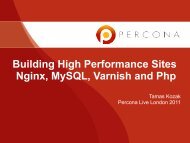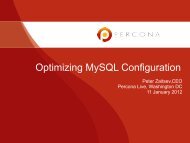Managing large sharded MySQL topologies with Jetpants - Percona
Managing large sharded MySQL topologies with Jetpants - Percona
Managing large sharded MySQL topologies with Jetpants - Percona
Create successful ePaper yourself
Turn your PDF publications into a flip-book with our unique Google optimized e-Paper software.
<strong>Managing</strong> Large Sharded<br />
Topologies <strong>with</strong> <strong>Jetpants</strong><br />
Evan Elias<br />
<strong>Percona</strong> Live New York 2012
About <strong>Jetpants</strong><br />
• Automation toolkit for handling monstrously <strong>large</strong> <strong>MySQL</strong> database<br />
<strong>topologies</strong><br />
• NOT a middleware server, storage engine, or replication replacement<br />
• Command line tool for common operational tasks (splitting shards,<br />
cloning replicas, performing master promotions, etc)<br />
• Usable as a library to provide a fully scriptable object model for your<br />
DB topology<br />
• Open source (Apache license) and written in Ruby<br />
<strong>Managing</strong> <strong>large</strong> <strong>sharded</strong> <strong>topologies</strong> <strong>with</strong> <strong>Jetpants</strong>
Motivations for <strong>Jetpants</strong><br />
1. Split range-based shards<br />
2. Automate operational tasks to reduce human error and<br />
time<br />
3. Provide reusable library for complex data migrations<br />
<strong>Managing</strong> <strong>large</strong> <strong>sharded</strong> <strong>topologies</strong> <strong>with</strong> <strong>Jetpants</strong>
Why range-based sharding?<br />
• Didn't want to use a lookup table, since that's a SPOF and can hit its<br />
own size issues<br />
• Didn't want to use a modulo or hashing scheme, too complex to<br />
rebalance given our growth rate<br />
• To reduce operational complexity, we didn't want pre-allocation of<br />
thousands of tiny shards, or initially colocate shards per <strong>MySQL</strong><br />
instance or machine<br />
• Decided on a range-based sharding scheme, <strong>with</strong> blog ID as sharding<br />
key. Now we just needed a way to split shards efficiently based on<br />
ranges of blog IDs.<br />
<strong>Managing</strong> <strong>large</strong> <strong>sharded</strong> <strong>topologies</strong> <strong>with</strong> <strong>Jetpants</strong>
Shard split automation prereqs<br />
• Ability to clone slaves quickly<br />
• Fast bulk import/export of portions of a data set<br />
• Config file generation<br />
• Automation around replication discovery, set-up, tear-down<br />
<strong>Managing</strong> <strong>large</strong> <strong>sharded</strong> <strong>topologies</strong> <strong>with</strong> <strong>Jetpants</strong>
Reducing human error<br />
• In-house system, Collins, to track hardware asset state<br />
• Wanted <strong>MySQL</strong> topology changes (master promotions, slave cloning,<br />
etc) to be fully automated, AND immediately reflected in Collins<br />
• Essential because we have a relatively <strong>large</strong> <strong>MySQL</strong> footprint vs small<br />
employee headcount<br />
<strong>Managing</strong> <strong>large</strong> <strong>sharded</strong> <strong>topologies</strong> <strong>with</strong> <strong>Jetpants</strong>
Tumblr’s Scale, Oct 2012<br />
• 103 billion rows on masters<br />
• 28 terabytes of distinct relational data<br />
• 201 dedicated <strong>MySQL</strong> servers, grouped into<br />
5 global pools and 58 shard pools<br />
• Grows by 3 or 4 shard pools per month<br />
<strong>Managing</strong> <strong>large</strong> <strong>sharded</strong> <strong>topologies</strong> <strong>with</strong> <strong>Jetpants</strong>
Number of DBAs at Tumblr<br />
<strong>Managing</strong> <strong>large</strong> <strong>sharded</strong> <strong>topologies</strong> <strong>with</strong> <strong>Jetpants</strong><br />
ZERO<br />
Just two engineers each spending ~50% of<br />
their time on non-maintenance <strong>MySQL</strong> work
This means three things<br />
1. We're hiring!<br />
2. <strong>Percona</strong> consultants are a lifesaver<br />
3. Automation must be powerful but still easy to use<br />
<strong>Managing</strong> <strong>large</strong> <strong>sharded</strong> <strong>topologies</strong> <strong>with</strong> <strong>Jetpants</strong>
Reusable code library<br />
Scriptable and pluggable manipulation of DBs<br />
• Custom scripts: shard an un<strong>sharded</strong> table, merge pools, defragment pools<br />
• Pluggable: backups, monitoring, query killers, etc<br />
• Generic enough to be useful for other companies<br />
<strong>Managing</strong> <strong>large</strong> <strong>sharded</strong> <strong>topologies</strong> <strong>with</strong> <strong>Jetpants</strong>
Implementation<br />
• Ruby objects representing hosts, <strong>MySQL</strong> instances, pools, shards, and<br />
the topology as a whole<br />
• Methods implementing state discovery, topology changes, etc<br />
• Command suite is a separate executable, using <strong>Jetpants</strong> as a library<br />
Takes user input and just calls these library methods as needed<br />
All domain knowledge is in the library, not the command suite<br />
So every command suite action is also scriptable via the library<br />
<strong>Managing</strong> <strong>large</strong> <strong>sharded</strong> <strong>topologies</strong> <strong>with</strong> <strong>Jetpants</strong>
How <strong>Jetpants</strong> clones replicas<br />
• Shut down mysql daemon on a standby slave<br />
• Much faster than a hot copy<br />
• Copy all data files using tar | pigz | nc<br />
• Can "chain" a serial copy to multiple destinations using tee and a fifo:<br />
http://engineering.tumblr.com/post/7658008285<br />
<strong>Managing</strong> <strong>large</strong> <strong>sharded</strong> <strong>topologies</strong> <strong>with</strong> <strong>Jetpants</strong>
How <strong>Jetpants</strong> exports data<br />
• Create a temporary mysql user <strong>with</strong> FILE privileges<br />
• Conceptually divide sharding key range into N chunks (tens, hundreds,<br />
or thousands — depends on table size)<br />
• Spawn up M threads in <strong>Jetpants</strong>, where M ≤ N<br />
• Each thread pulls a chunk range off the queue, does a SELECT ...<br />
INTO OUTFILE query <strong>with</strong> WHERE clause for that chunk, and repeats<br />
until no chunks left<br />
<strong>Managing</strong> <strong>large</strong> <strong>sharded</strong> <strong>topologies</strong> <strong>with</strong> <strong>Jetpants</strong>
How <strong>Jetpants</strong> imports data<br />
• Same chunking algorithm as export, but uses LOAD DATA INFILE ...<br />
CHARACTER SET binary<br />
• <strong>Jetpants</strong> disables binary logging before doing the import (major speed<br />
boost), re-enables it afterwards<br />
• Concurrent import doesn't work yet on tables <strong>with</strong> AUTO_INCREMENT,<br />
so set chunks=1 for these<br />
• <strong>Jetpants</strong> also leverages mysqldump -d to obtain DROP TABLE /<br />
CREATE TABLE statements when needed<br />
<strong>Managing</strong> <strong>large</strong> <strong>sharded</strong> <strong>topologies</strong> <strong>with</strong> <strong>Jetpants</strong>
Import/export use cases<br />
• Defragmentation: Export all data, drop and recreate tables, import all<br />
data<br />
• Data set reduction in shard split: Export range of data, drop and<br />
recreate tables, import range of data<br />
• Data migration / merging pools: Export all data, send it somewhere<br />
else, import it there<br />
• Differential backups: Export all data, diff it against previous export<br />
(not recommended, just a crazy idea)<br />
<strong>Managing</strong> <strong>large</strong> <strong>sharded</strong> <strong>topologies</strong> <strong>with</strong> <strong>Jetpants</strong>
3 magic bullets of data migration<br />
Useful background for shard splits, pool merges, initial sharding, major<br />
schema changes<br />
1. Redundant writes<br />
2. Move reads separately, before stopping redundant writes<br />
3. Chose a cutover ID “in the future”<br />
<strong>Managing</strong> <strong>large</strong> <strong>sharded</strong> <strong>topologies</strong> <strong>with</strong> <strong>Jetpants</strong>
Redundant writes<br />
• Make your app write data to an old source and a new source, until the<br />
migration is finished<br />
• The writes to the new source are "dark writes" until migration<br />
completes — nothing reads from them yet<br />
• If you're not making schema changes, you can leverage <strong>MySQL</strong><br />
replication for this in interesting ways<br />
• Otherwise, you can do the redundant writes at the app or service level<br />
<strong>Managing</strong> <strong>large</strong> <strong>sharded</strong> <strong>topologies</strong> <strong>with</strong> <strong>Jetpants</strong>
Alter read pattern before writes<br />
No way to instantaneously update app configuration on every app<br />
server. So if you adjust reads and writes simultaneously, config deploy<br />
lag causes inconsistency:<br />
• Host A gets new config, sends writes only to new data source<br />
• Host B doesn't have new config yet, is still reading and writing to old<br />
data source, doesn't see host A's writes<br />
Solution is to use two steps:<br />
1. Push out config moving reads to new data source<br />
2. Push out config stopping redundant writes to old data source<br />
<strong>Managing</strong> <strong>large</strong> <strong>sharded</strong> <strong>topologies</strong> <strong>with</strong> <strong>Jetpants</strong>
Future Cutover<br />
• Always deploy cutover logic in advance of it having any impact<br />
• Say your last shard has range [5001, infinity), and currently<br />
MAX(id) = 6800<br />
• Range-wise, a lot of your data set is on this one shard. You should add<br />
a new shard after it.<br />
• Choose cutover logic to begin on ID 7001: this shard now handles<br />
[5001, 7000] and new last shard handles [7001, infinity)<br />
• Deploy this everywhere prior to ID 7001 existing. No need to move<br />
data and no data inconsistencies from configuration deploy lag!<br />
<strong>Managing</strong> <strong>large</strong> <strong>sharded</strong> <strong>topologies</strong> <strong>with</strong> <strong>Jetpants</strong>
How <strong>Jetpants</strong> splits a shard<br />
• Rebalance an overly-<strong>large</strong> shard by dividing it into N new shards, of<br />
even or uneven size<br />
• Speed<br />
• No locks<br />
• No application logic<br />
• Divide a billion-row shard in only a few hours<br />
• Full read and write availability: shard-splitting process has no impact<br />
on live application performance, functionality, or data consistency,<br />
since it isn’t performed “in place”<br />
<strong>Managing</strong> <strong>large</strong> <strong>sharded</strong> <strong>topologies</strong> <strong>with</strong> <strong>Jetpants</strong>
Standby Slave, Standby Slave,<br />
blogs 1-1000 blogs 1-1000<br />
<strong>Managing</strong> <strong>large</strong> <strong>sharded</strong> <strong>topologies</strong> <strong>with</strong> <strong>Jetpants</strong><br />
R/W<br />
Parent Master, blogs 1-1000,<br />
all app reads/writes
Standby Slave, Standby Slave,<br />
blogs 1-1000 blogs 1-1000<br />
<strong>Managing</strong> <strong>large</strong> <strong>sharded</strong> <strong>topologies</strong> <strong>with</strong> <strong>Jetpants</strong><br />
R/W<br />
Parent Master, blogs 1-1000,<br />
Clone Clone<br />
Standby Slave,<br />
blogs 1-1000<br />
all app reads/writes<br />
Standby Slave,<br />
blogs 1-1000
Standby Slave, Standby Slave,<br />
blogs 1-1000 blogs 1-1000<br />
<strong>Managing</strong> <strong>large</strong> <strong>sharded</strong> <strong>topologies</strong> <strong>with</strong> <strong>Jetpants</strong><br />
R/W<br />
Parent Master, blogs 1-1000,<br />
Child Shard<br />
Master,<br />
blogs 1-500<br />
all app reads/writes<br />
Child Shard<br />
Master,<br />
blogs 501-1000<br />
Two slaves export different<br />
halves of the dataset, drop<br />
and recreate their tables,<br />
and then import the data
Standby Slave, Standby Slave,<br />
blogs 1-1000 blogs 1-1000<br />
<strong>Managing</strong> <strong>large</strong> <strong>sharded</strong> <strong>topologies</strong> <strong>with</strong> <strong>Jetpants</strong><br />
R/W<br />
Parent Master, blogs 1-1000,<br />
Child Shard<br />
Master,<br />
blogs 1-500<br />
Standby Slaves<br />
blogs 1-500<br />
all app reads/writes<br />
Child Shard<br />
Master,<br />
blogs 501-1000<br />
Standby Slaves<br />
blogs 501-1000<br />
Every pool needs two<br />
standby slaves, so spin<br />
them up for the child<br />
shard pools
Standby Slave, Standby Slave,<br />
blogs 1-1000 blogs 1-1000<br />
<strong>Managing</strong> <strong>large</strong> <strong>sharded</strong> <strong>topologies</strong> <strong>with</strong> <strong>Jetpants</strong><br />
W<br />
Parent Master, blogs 1-1000,<br />
R<br />
Child Shard<br />
Master,<br />
blogs 1-500<br />
Standby Slaves<br />
blogs 1-500<br />
all app writes (which then<br />
replicate to children)<br />
R<br />
Child Shard<br />
Master,<br />
blogs 501-1000<br />
Standby Slaves<br />
blogs 501-1000<br />
Reads now go to children<br />
for appropriate queries to<br />
these ranges
Standby Slave, Standby Slave,<br />
blogs 1-1000 blogs 1-1000<br />
<strong>Managing</strong> <strong>large</strong> <strong>sharded</strong> <strong>topologies</strong> <strong>with</strong> <strong>Jetpants</strong><br />
Parent Master, blogs 1-1000,<br />
Standby Slaves<br />
blogs 1-500<br />
no longer in use by app<br />
R/W R/W<br />
Child Shard<br />
Master,<br />
blogs 1-500<br />
Child Shard<br />
Master,<br />
blogs 501-1000<br />
Standby Slaves<br />
blogs 501-1000<br />
Reads and writes now go to<br />
children for appropriate<br />
queries to these ranges
Standby Slave, Standby Slave,<br />
blogs 1-1000 blogs 1-1000<br />
<strong>Managing</strong> <strong>large</strong> <strong>sharded</strong> <strong>topologies</strong> <strong>with</strong> <strong>Jetpants</strong><br />
Parent Master, blogs 1-1000<br />
Global read-only set<br />
App user dropped<br />
R/W R/W<br />
Shard<br />
Master,<br />
blogs 1-500<br />
Standby Slaves<br />
blogs 1-500<br />
Shard<br />
Master,<br />
blogs 501-1000<br />
Standby Slaves<br />
blogs 501-1000<br />
These are now complete<br />
shards of their own<br />
(but <strong>with</strong> some surplus data<br />
that needs to be removed)
X X<br />
Standby Slave,<br />
blogs 1-1000<br />
Recycle soon<br />
Standby Slave,<br />
blogs 1-1000<br />
Recycle soon<br />
<strong>Managing</strong> <strong>large</strong> <strong>sharded</strong> <strong>topologies</strong> <strong>with</strong> <strong>Jetpants</strong><br />
X<br />
Deprecated Parent Master, blogs 1-1000<br />
Recycle soon<br />
R/W R/W<br />
Shard<br />
Master,<br />
blogs 1-500<br />
Standby Slaves<br />
blogs 1-500<br />
Shard<br />
Master,<br />
blogs 501-1000<br />
Standby Slaves<br />
blogs 501-1000<br />
Clean up data that<br />
replicated to the wrong<br />
shard
Why this matters<br />
"Resharding - I don't recommend it. You don't move users between<br />
shards ... From experience I will claim that for a <strong>large</strong> and busy site,<br />
[automating] this is a one-year project." — Mark Callaghan, Facebook<br />
• <strong>Jetpants</strong> is open source, so you won’t have to spend a year<br />
reimplementing this automation<br />
• Instead just spend a few days writing custom plugins to tie into your<br />
asset tracker and the rest of your environment<br />
• We will happily merge your changes and patches upstream<br />
<strong>Managing</strong> <strong>large</strong> <strong>sharded</strong> <strong>topologies</strong> <strong>with</strong> <strong>Jetpants</strong>
Merging pools<br />
Why?<br />
• Can fix overzealous partitioning<br />
• Hardware has scaled up, SSDs higher capacity now<br />
<strong>Managing</strong> <strong>large</strong> <strong>sharded</strong> <strong>topologies</strong> <strong>with</strong> <strong>Jetpants</strong>
Merging pools<br />
How to merge pool A into pool B<br />
1. Export all data on a standby slave of pool A<br />
2. Copy data to a standby slave of pool B, and import there<br />
3. Clone that slave over top all other nodes in pool B (one at a time,<br />
swapping roles and promoting as needed)<br />
4. Make the master of B slave from the master of A<br />
5. Move app reads for pool A to pool B<br />
6. Move app writes for pool A to pool B, tear down replication, kill A<br />
<strong>Managing</strong> <strong>large</strong> <strong>sharded</strong> <strong>topologies</strong> <strong>with</strong> <strong>Jetpants</strong>
Remote command execution<br />
Object model includes hosts, and the ability to run arbitrary commands<br />
via SSH<br />
# Scan spare pool nodes for failed drives<br />
selector = {operation: 'and', details: true, type:<br />
'SERVER_NODE', primary_role: 'DATABASE', status:<br />
'Provisioned'}<br />
nodes = Plugin::JetCollins.find(selector).map &:to_db<br />
nodes.concurrent_each {|n| n.output n.ssh_cmd '/usr/<br />
StorMan/arcconf getconfig 1 | grep -i degraded'}<br />
<strong>Managing</strong> <strong>large</strong> <strong>sharded</strong> <strong>topologies</strong> <strong>with</strong> <strong>Jetpants</strong>
Map/Reduce in <strong>MySQL</strong>?<br />
Not exactly, but you can do distributed computation for the “map” step<br />
# Calculate a global max<br />
<strong>Jetpants</strong>.topology.shards.concurrent_map {|s|<br />
s.query_return_first_value 'SELECT MAX(id) from<br />
foo'}.max<br />
# Distributed counts (naive implementation)<br />
<strong>Jetpants</strong>.topology.shards.concurrent_map {|s|<br />
s.query_return_first_value 'SELECT COUNT(*) from<br />
foo'}.reduce(0) {|total, shard_count| total +<br />
shard_count}<br />
<strong>Managing</strong> <strong>large</strong> <strong>sharded</strong> <strong>topologies</strong> <strong>with</strong> <strong>Jetpants</strong>
Auto-sharding in <strong>MySQL</strong>?!?<br />
• Hypothetical, and not necessarily recommended<br />
• Would probably would be < 500 lines of Ruby code in a cloud<br />
environment<br />
• Develop a daemon process using <strong>Jetpants</strong> as a library<br />
• Monitor shard sizes and peak I/O utilization; use shard#split method on<br />
worst offender if over a certain size or load<br />
• Would need ability to automatically deploy app configuration changes<br />
• Would need ability to monitor spare host list size, and spin up new<br />
nodes when needed<br />
<strong>Managing</strong> <strong>large</strong> <strong>sharded</strong> <strong>topologies</strong> <strong>with</strong> <strong>Jetpants</strong>
Plugin system<br />
• Built using Ruby metaprogramming<br />
• Hooks: Plugins can easily insert code before or after any method in<br />
any <strong>Jetpants</strong> class. They "stack", allowing multiple plugins to hook into<br />
the same place, <strong>with</strong> support for specifying priority numbers to resolve<br />
conflicts.<br />
• Overrides: Plugins may also completely override any method in any<br />
<strong>Jetpants</strong> class<br />
• Config: Plugins can accept arbitrary configuration data in <strong>Jetpants</strong><br />
YAML config file<br />
• Plugins should be stand-alone Ruby gems<br />
<strong>Managing</strong> <strong>large</strong> <strong>sharded</strong> <strong>topologies</strong> <strong>with</strong> <strong>Jetpants</strong>
Plugins: monitoring<br />
• <strong>Jetpants</strong> DB class has methods enable_monitoring and<br />
disable_monitoring; stock implementation is a no-op<br />
• Called whenever appropriate (<strong>MySQL</strong> instance stopped, replication<br />
stopped, etc)<br />
• Plugin should override these, or use stackable hooks like<br />
DB#before_enable_monitoring and DB#before_disable_monitoring<br />
<strong>Managing</strong> <strong>large</strong> <strong>sharded</strong> <strong>topologies</strong> <strong>with</strong> <strong>Jetpants</strong>
Plugins: asset tracker<br />
• <strong>Jetpants</strong> intentionally does not store persistent state on its own<br />
• Most <strong>large</strong> sites presumably already have a hardware asset tracking<br />
system: something that has a list of all hosts, along <strong>with</strong> their type, role,<br />
pool, etc<br />
• This makes more sense as the single point of truth<br />
• So just write a plugin to make <strong>Jetpants</strong> query this<br />
• At start-up: discover list of pools, pre-populate <strong>Jetpants</strong> topology object<br />
• Upon any topology change from <strong>Jetpants</strong>: inform the asset tracker<br />
appropriately<br />
<strong>Managing</strong> <strong>large</strong> <strong>sharded</strong> <strong>topologies</strong> <strong>with</strong> <strong>Jetpants</strong>
Plugins: MHA for promotion logic<br />
• MHA is a master promotion tool that solves slave consistency issues<br />
by diff’ing the binlogs<br />
• Manual failover: <strong>Jetpants</strong> plugin could override the<br />
Pool#master_promotion method to figure out which slave has highest<br />
binlog coordinates, shell out to masterha_master_switch <strong>with</strong><br />
--new_master_host param specifying that slave, and then update<br />
topology on <strong>Jetpants</strong> side<br />
• Automatic failover: Not recommended in general, but could run MHA<br />
manager as usual. Write scripts that notify <strong>Jetpants</strong> about topology<br />
changes via MHA’s master_ip_failover_script and<br />
master_ip_online_change_script config params<br />
<strong>Managing</strong> <strong>large</strong> <strong>sharded</strong> <strong>topologies</strong> <strong>with</strong> <strong>Jetpants</strong>
<strong>Jetpants</strong> Roadmap<br />
• Nonstandard ports and multi-instance-per-host support<br />
• Support more environments (<strong>MySQL</strong> versions, Linux distros, JRuby)<br />
• Collins asset tracker integration plugin<br />
• Support master-master and other nonstandard replication<br />
configurations<br />
• Functional tests<br />
• Configurable/pluggable compression and file transfer<br />
<strong>Managing</strong> <strong>large</strong> <strong>sharded</strong> <strong>topologies</strong> <strong>with</strong> <strong>Jetpants</strong>
<strong>Managing</strong> <strong>large</strong> <strong>sharded</strong> <strong>topologies</strong> <strong>with</strong> <strong>Jetpants</strong><br />
Questions?<br />
Email: me@evanelias.com







